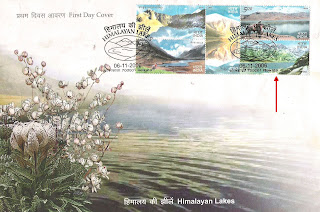Very little is known about the postal history of Sikkim. Though post offices in Sikkim started in 1888 in Dulapchin (now Dalapchand), near Rongli and meager information has been established so far. For a stamp-sized state of Sikkim, 6th November 2006 held a moment of glory and recognition in terms of world philately. Indian Postage featured a postal stamp on Changu Lake in a group of five lakes from different parts of India. The Changu Lake stamp with Rs 5 denomination features among the five Himalayan Lakes of India that include Roop Kund, Sela, Tsomo Riri, and Chandra Tal. The stamp and First Day Cover had been designed by Bharati Mirchandani and the Cancellation was designed by Alka Sharma. The stamp is printed in the photogravure process and printed at India Security Press, Nasik.
It was for the first time in the history of Indian Postage, an individual theme from Sikkim got introduced in the Indian postage stamp. For the last few years, efforts were made to feature individual themes from Sikkim. Along the lines, various tourist destinations including Rumtek Monastery, Changu (Tsangu) Lake, Guru Dongmor Lake, Natula Pass, and the cultural diversity of Sikkim were discussed but it was the more popular Changu (Tsangu) Lake that made history. Truly no doubt Changu Lake has been one of the major tourist attractions over the years and its incomparable scenic beauty reflects the charisma of the small state of Sikkim.
A new record was set on the rail track at Siliguri Junction on June 5, 2006, when for the first time in India and across the globe, a running toy train philatelic exhibition was jointly organized by Siliguri Philatelic Society and Sikkim Philatelic Club. The distance of over 31 km was covered over 10 hours. The route of the Toy Train was from Siliguri Junction to Agony Point, with a halt at Sukuna. The event even finds a mention at Stanly Gibbon's book, bible in philately world.
For more than thirty years since the state of Sikkim joined the Indian Union, Sikkim has been struggling for its presence in Indian postage. Apart from four Mt Kanchenjunga stamps on three separate occasions (1955, 1978, and 1988), Red Panda (1955), Blood Pheasant (1963), and Flora and Fauna of North East India (2006), a single illustration of Yumthang valley in 1982 Himalayan Flowers First Day Cover and a handful of Sikkim Special Covers and Army Covers is all we had our contributions towards the great Indian philately.
Despite the fact that Sikkim first made its presence felt in the world of philately way back in 1935 when in this small Himalayan Kingdom a unique postal experiment was conducted by a man named Stephen Hector Smith. The postal experiment got popular with the name Sikkim Rocket mail Experiment 1935. In the book “From the diary of Stephen Smith” written by Stephen Smith relating to rockets mail experiments, it has been mentioned that the Sikkim experiment was the most successful among all the pioneering efforts in rocket mailing the world over. The five places where the experiments were conducted were Gangtok, Sarumsa, Ray, Singtam, and Rangpo.
Stephen Hector Smith, a pioneer in Indian Rocket mail history chooses Sikkim for his experiment because of its geographical features and mountains. Sikkim is also the first country in the world to successfully dispatch by means of a rocket, a parcel containing small quantities of such useful articles as medicine, tobacco, tea, sugar, etc. Those people who helped the Sikkim Rocket experiment succeed included Chogyal Tashi Namgyal, CE Dudley, General Secretary to the Chogyal, Tashi Dadul Densapa, Private Secretary, Rai Sahib Faqir Chand Jali, the state engineer, and F Williamson, British Political Officer.
This note on the history of Philately in Sikkim shall not be completed without mentioning the Revenue Stamps of Sikkim that have been continuing prior to the early 1920s. The oldest found cancellation on Sikkim Revenue Stamp dates back to 8th October 1928 dispatched from Mangan B.O to Gangtok. The central design of the stamp has the southeast face of Mt. Siniolchu, in the north of Gangtok. The Photograph was taken by Hoffmann in the illustration of Claude White’s book “Sikkim and Bhutan”.
With the British influence in the small Himalayan kingdom of Sikkim in the late 1880s, it goes credit to them that they could establish Telegraph offices in Sikkim to the remotest corner of Gnathang where the altitude was as high as 12,000 feet. An interesting note says that till the 1950s the only post office the eastern world ever knew about Sikkim was the Rhenock Post Office from where the floral seeds of Sikkim Himalayan flora were exported worldwide by the world-famous Chandra Nursery of Rhenock.


Very interesting to read about the stamps of Sikkim. I wish the state of Sikkim was independent again under the Chogyal. Indian imperialism in Sikkim and Chinese imperialism in Tibet ruined the culture and lives of these two countries.
ReplyDeleteGreg Erickson
eestivabariik@yahoo.com
I am a Philatelist residing at Satna (M.P.). My main theme is JAINISM. I want 5 FDC (First day covers) of 17-4-2012 Godiji temple Stamp from Siliguri GPO Philatelic Bureau for my collection. I do not know any Philatelist of Vijayawada hence giving you trouble. I shall be highly obliged if you kindly arrange these FDCs for me.I will remit the amount with postage etc.
ReplyDeletePlease see.
With kind regards,
- Sudhir Jain,
Universal Cables Ltd.,
SATNA (M.P.) 485 005.
Ph. : 07672 257121, 41400
Mobile : 09425174190.